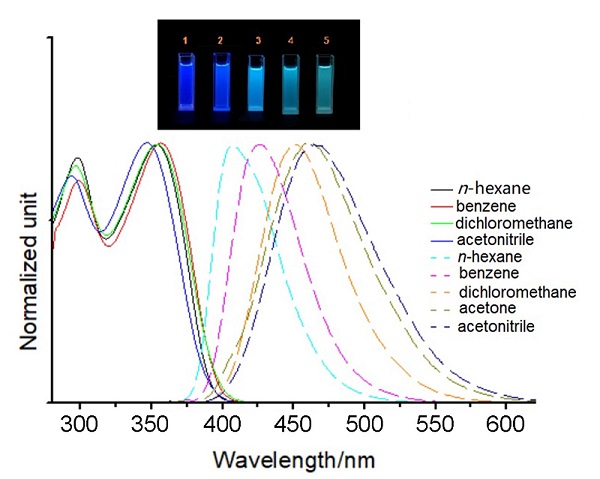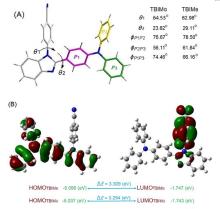Acta Chimica Sinica ›› 2019, Vol. 77 ›› Issue (11): 1194-1202.DOI: 10.6023/A19080306 Previous Articles Next Articles
Article
投稿日期:2019-08-19
发布日期:2019-10-22
通讯作者:
夏敏
E-mail:xiamin@zstu.edu.cn
基金资助:
Liu Xiaojing, Jia Yanrong, Jiang Hao, Gao Guanlei, Xia Min*( )
)
Received:2019-08-19
Published:2019-10-22
Contact:
Xia Min
E-mail:xiamin@zstu.edu.cn
Share
Liu Xiaojing, Jia Yanrong, Jiang Hao, Gao Guanlei, Xia Min. Two Polymorphs of Triphenylamine-substituted Benzo[d]imidazole: Mechanoluminescence with Different Colors and Mechanofluorochromism with Emission Shifts in Opposite Direction[J]. Acta Chimica Sinica, 2019, 77(11): 1194-1202.




| [1] | (a) Peng, B. Y.; Xu, S. D.; Chi, Z. G.; Zhang, X. Q.; Zhang, Y.; Xu, J. R. Prog. Chem. 2013, 25, 1805 (in Chinese). |
| (彭邦银, 许适当, 池振国, 张锡奇, 张艺, 许家瑞, 化学进展, 2013, 25, 1805.) | |
| (b) Di, B. H.; Chen, Y. L. Chin. Chem. Lett. 2018, 29, 245; | |
| (c) Yuan, Y.; Yuan, W.; Chen, Y. L. Sci. China Mater. 2016, 59, 507; | |
| (d) Yuan, W.; Yuan, Y.; Chen, Y. L. Acta Polym. Sinica 2016, 11, 1495 (in Chinese). | |
| (袁伟, 袁媛, 陈于蓝, 高分子学报, 2016, 11, 1495.) | |
| (e) Yang, J.; Chi, Z.; Zhu, W.; Tang, B. Z.; Li, Z. Sci. China Chem. 2019, 62, 1090; | |
| (f) Li, Q.; Li, Z. Adv. Sci. 2017, 4, 1600484. | |
| [2] | (a) Dong, Y. Q.; Lam, J. W. Y.; Tan, B. Z. J. Phys. Chem. Lett. 2015, 6, 3429; |
| (b) Chi, Z.; Zhang, X.; Xu, B.; Zhou, X.; Ma, C.; Zhang, Y.; Liu, S.; Xu, J. Chem. Soc. Rev. 2012, 41, 3878; | |
| (c) Wang, C.; Li, Z. Mater. Chem. Front. 2017, 1, 2174; | |
| (d) Yang, Z.; Chi, Z.; Mao, Zhang, Z. Y.; Liu, S.; Zhao, J. M.; Aldred, P.; Chi, Z. Mater. Chem. Front. 2018, 2, 861; | |
| (e) Varughese, S. J. Mater. Chem. C 2014, 2, 3499; | |
| (f) Sagara, Y.; Yamane, S.; Mitani, M.; Weder, C.; Kato, T. Adv. Mater. 2016, 28, 1073; | |
| (g) Bian, G. F.; Huang, H.; Zhan, L. L.; Lü, X. J.; Cao, F.; Zhang, C.; Zhang, Y. J. Acta Phys.-Chim. Sin. 2016, 32, 589(in Chinese). | |
| (边高峰, 黄华, 占玲玲, 吕晓静, 曹枫, 张诚, 张玉建, 物理化学学报, 2016, 32, 589.) | |
| (h) Sun, J. B.; Zhang, G. H.; Jia, X. Y.; Xue, P. C.; Jia, J. H.; Lu, R. Acta Chim. Sinica 2016, 74, 165(in Chinese). | |
| (孙静波, 张恭贺, 贾小宇, 薛鹏冲, 贾俊辉, 卢然, 化学学报, 2016, 74, 165); | |
| (i) Ouyang, M.; Yu, C. H.; Zhang, Y. J.; Hu, B.; Lü, X. J.; Sun, J. W.; Zhang, C. Acta Phys.-Chim. Sin. 2012, 28, 2944(in Chinese). | |
| (欧阳密, 俞春辉, 张玉建, 胡彬, 吕晓静, 孙璟玮, 张诚, 物理化学学报, 2012, 28, 2944.) | |
| [3] | (a) Seki, T.; Takamatsu, Y.; Ito, H. J. Am. Chem. Soc. 2016, 138, 6252; |
| (b) Jin, M.; Seki, T.; Ito, H. J. Am. Chem. Soc. 2017, 139, 7452; | |
| (c) Yagai, S.; Okamura, S.; Nakano, Y.; Yamauchi, M.; Kishikawa, K.; Karatsu, T.; Kitamura, A.; Ueno, A.; Kuzuhara, D.; Yamada, H.; Seki, T.; Ito, H. Nat. Commun. 2014, 5, 4013. | |
| [4] | (a) Zheng, K.; Zheng, Y.; Peng, L.; Xiang, Y.; Tong, A. J. J. Phys. Chem. C 2017, 121, 21610; |
| (b) Lü, Y.; Liu, Y.; Ye, X.; Liu, G. F.; Tao, X. T. CrystEngComm 2015, 17, 526; | |
| (c) Chung, K.; Kwon, M. S.; Leung, B. M.; Kim, J. S. ACS Cent. Sci. 2015, 1, 94. | |
| [5] | (a) Shi, P.; Duan, Y.; Wei, W.; Xu, Z.; Li, Z.; Han, T. J. Mater. Chem. C 2018, 6, 2476; |
| (b) Feng, C.; Wang, K.; Xu, Y.; Liu, L.; Zou, B.; Lu, P. Chem. Commun. 2016, 52, 3836; | |
| (c) Wang, L.; Wang, K.; Zou, B.; Ye, K.; Zhang, H.; Wang, Y. Adv. Mater. 2015, 27, 2918; | |
| (d) Xie, W.-Z.; Zheng, H.-C.; Zheng, Y.-S. J. Mater. Chem. C 2017, 5, 10462. | |
| [6] | (a) Hirata, S.; Watanabe, T. Adv. Mater. 2006, 18, 2725; |
| (b) Lim, S. J.; An, B. K.; Jung, S. D.; Chung, M. A.; Park, S. Y. Angew. Chem., Int. Ed. 2004, 43, 6346; | |
| (c) Olson, C. E.; Previte, M. J. R.; Fourkas, J. T. Nat. Mater. 2002, 1, 225; | |
| (d) Irie, M.; Fukaminato, T.; Sasaki, T.; Tamai, N.; Kawai, T. Nature 2002, 420, 759. | |
| [7] | (a) Kishimura, A.; Yamashita, T.; Yamaguchi, K.; Aida, T. Nat. Mater. 2005, 4, 546; |
| (b) Zhu, X.; Liu, R.; Li, Y.; Huang, H.; Wang, Q.; Wang, D.; Zhu, X.; Liu, S.; Zhu, H. Chem. Commun. 2014, 50, 12951; | |
| (c) Qi, Q.; Liu, Y.; Fang, X.; Zhang, Y.; Chen, P.; Wang, Y.; Yang, B.; Xu, B.; Tian, W.; Zhang, S. X. RSC Adv. 2013, 3, 7996; | |
| (d) Kumar, P.; Dwivedi, J.; Gupta, B. K. J. Mater. Chem. C 2014, 2, 10468; | |
| (e) Lu, X.-L.; Xia, M. J. Mater. Chem. C 2016, 4, 9350. | |
| [8] | (a) Yuan, W. Z.; Tan, Y.; Gong, Y.; Lu, P.; Lam, J. W. Y.; Shen, X. Y.; Feng, C.; Sung, H. Y.; Lu, Y.; Williams, I. D.; Sun, J. Z.; Zhang, Y.; Tang, B. Z. Adv. Mater. 2013, 25, 2837; |
| (b) Li, C.; Tang, X.; Zhang, L.; Li, C.; Liu, Z.; Bo, Z.; Dong, Y. Q.; Tian, Y.-H.; Dong, Y.; Tang, B. Z. Adv. Optical Mater. 2015, 3, 1184; | |
| (c) Naeem, K. C.; Subhakumari, A.; Varughese, S.; Nair, V. C. J. Mater. Chem. C 2015, 3, 10225; | |
| (d) Sun, J.; Han, J.; Liu, Y.; Duan, Y.; Han, T.; Yuan, J. J. Mater. Chem. C 2016, 4, 8276; | |
| (e) Xue, P.; Yang, Z.; Chen, P. J. Mater. Chem. C 2018, 6, 4994. | |
| [9] | (a) Sagara, Y.; Kato, T. Angew. Chem. Int. Ed. 2011, 50, 9128; |
| (b) Yoon, S.-J.; Chung, J. W.; Gierschner, J.; Kim, K. S.; Choi, M.-G.; Kim, D.; Park, S. Y. J. Am. Chem. Soc. 2010, 132, 13675; | |
| (c) Sun, H.; Liu, S.; Lin, W.; Zhang, K. Y.; Lü, W.; Huang, W.; Huo, F.; Yang, H.; Jenkins, G.; Zhao, Q.; Huang, W. Nat. Commun. 2014, 5, 3601; | |
| (d) Zhang, K. Y.; Liu, S.; Zhao, Q.; Huang, W. Coord. Chem. Rev. 2016, 319, 180; | |
| (e) Chen, X.; Sun, G.; Zhang, T.; Liu, S.; Zhao, Q.; Huang, W. Adv. Mater. 2016, 28, 7137; | |
| (f) Zhao, Q.; Xu, W.; Sun, H.; Yang, J.; Zhang, K. Y.; Liu, S.; Ma, Y.; Huang, W. Adv. Opt. Mater. 2016, 4, 1167; | |
| (g) Lin, W.; Zhao, Q.; Sun, H.; Zhang, K. Y.; Yang, H.; Yu, Q.; Zhou, X.; Guo, S.; Liu, S.; Huang, W. Adv. Opt. Mater. 2015, 3, 368; | |
| (h) Han, J.; Sun, J.; Li, Y.; Duan, Y.; Han, T. J. Mater. Chem. C 2016, 4, 9287. | |
| [10] |
(a) Xu, B.; Li, W.; He, J.; Wu, S.; Zhu, Q.; Yang, Z.; Wu, Y.-C.; Zhang, Y.; Jin, C.; Lu, P.-Y.; Chi, Z.; Liu, S.; Xu, J.; Bryce, M. R. Chem. Sci. 2016, 7, 5307;
doi: 10.6023/A17110504 |
|
(b) Xu, S.; Liu, T.; Mu, Y.; Wang, Y.-F.; Chi, Z.; Lo, C.-C.; Liu, S.; Zhang, Y.; Lien, A.; Xu, J. Angew. Chem. 2015, 127, 888;
doi: 10.6023/A17110504 |
|
|
(c) Yang, J.; Ren, Z.; Xie, Z.; Liu, Y.; Wang, C.; Xie, Y.; Peng, Q.; Xu, B.; Tian, W.; Zhang, F.; Chi, Z.; Li, Q.; Li, Z. Angew. Chem. Int. Ed. 2017, 56, 880;
doi: 10.6023/A17110504 |
|
|
(d) Neen, K. K.; Sudhakar, P.; Dipak, K.; Thilagar, P. Chem. Commun. 2017, 53, 3641;
doi: 10.6023/A17110504 |
|
|
(e) Xu, B.; He, J.; Mu, Y.; Zhu, Q.; Wu, S.; Wang, Y.; Zhang, Y.; Jin, C.; Lo, C.; Chi, Z.; Lien, A.; Liu, S.; Xu, J. Chem. Sci. 2015, 6, 3236;
doi: 10.6023/A17110504 |
|
|
(f) Nakayama, H.; Nishida, J.; Takada, N.; Sato, H.; Yamashita, Y. Chem. Mater. 2012, 24, 671;
doi: 10.6023/A17110504 |
|
|
(g) Nishida, J.; Ohura, H.; Kita, Y.; Hasegawa, H.; Kawase, T.; Takada, N.; Sato, H.; Sei, Y.; Yamashita, Y. J. Org. Chem. 2016, 81, 433;
doi: 10.6023/A17110504 |
|
|
(h) Liu, M. L.; Wu, Q.; Shi, H. F.; An, Z. F.; Huang, W. Acta Chim. Sinica 2018, 76, 246(in Chinese). (刘明丽, 吴琪, 史慧芳, 安众福, 黄维, 化学学报, 2018, 76, 246.)
doi: 10.6023/A17110504 |
|
| [11] | (a) Wang, C.; Xu, B.; Li, M.; Chi, Z.; Xie, Y.; Li, Q.; Li, Z. Mater. Horiz. 2016, 3, 220; |
| (b) Liu, F.; Tu, J.; Wang, X.; Wang, J.; Gong, Y.; Han, M.; Dang, X.; Liao, Q.; Peng, Q.; Li, Q.; Li, Z. Chem. Commun. 2018, 54, 5598. | |
| [12] | (a) Yang, J.; Ren, Z.; Chen, B.; Fang, M.; Zhao, Z.; Tang, B. Z.; Peng, Q.; Li, Z. J. Mater. Chem. C 2017, 5, 9242; |
| (b) Yang, J.; Ren, Z.; Xie, Z.; Liu, Y.; Wang, C.; Xie, Y.; Peng, Q.; Xu, B.; Tian, W.; Zhang, F.; Chi, Z.; Li, Q.; Li, Z. Angew. Chem. Int. Ed. 2017, 56, 880. | |
| [13] |
Xie Z.; Yu T.; Chen J.; Ubba E.; Wang L.; Mao Z.; Su T.; Zhang Y.; Aldred M. P.; Chi Z. Chem. Sci. 2018, 9, 5787
doi: 10.1039/C8SC01703D |
| [14] |
Hardy G. E.; Baldwin J. C.; Zink J. I.; Kaska W. C.; Liu P.; Dubois L. J. Am. Chem. Soc. 1977, 99, 3552
doi: 10.1021/ja00453a002 |
| [15] |
Zink J. I.; Chandra B. P. J. Phys. Chem. 1982, 86, 5
doi: 10.1021/j100390a003 |
| Viewed | ||||||
|
Full text |
|
|||||
|
Abstract |
|
|||||